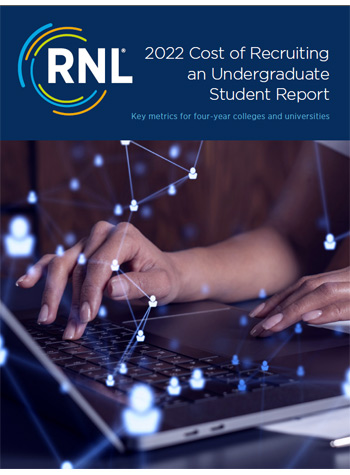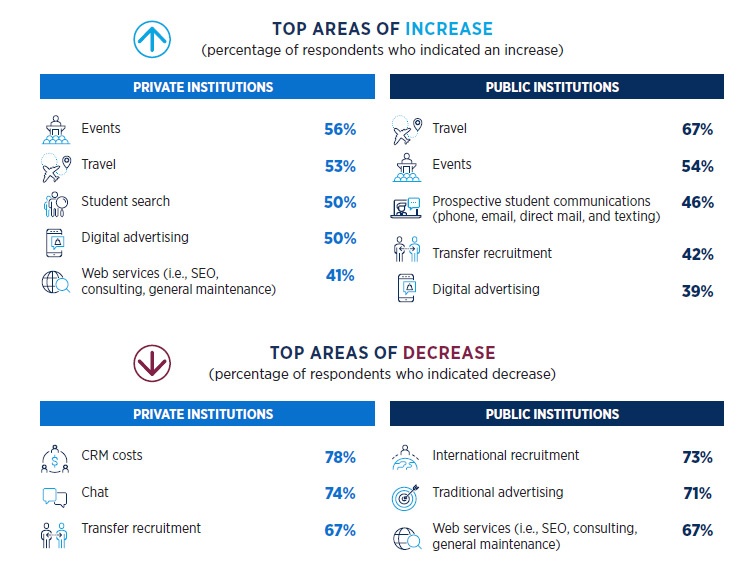enrollment
3 Key Takeaways from the Cost of Recruiting an Undergraduate Student Report
It’s spring and that means it’s the middle of budget planning for the next year. I worked in admissions for a dozen years before I came to RNL, and I know how challenging it is to allocate those budgets and have conversations with the board to identify what’s needed to move the campus forward. That’s also something I have done as a consultant with our partner campuses, and one of the things that helps with planning are benchmarks and comparison data to your peer institutions.
The Cost of Recruiting an Undergraduate Student Report is a national survey RNL conducts that provides one of the most helpful benchmarks to enrollment managers: how much institutions spend on average to recruit a single undergraduate student. It also includes many other insightful metrics and benchmarks. Here are three things in particular I think you should know from the report.
1. What does it cost to recruit a traditional high school student?
For four-year private institutions, it costs on average $2,795 to recruit a student. On the public institution side, that number is $494. Now, that number includes everything, not just your admissions operational budget, but salaries, travel, events budgets, your marketing and communications budget—basically any dollars that are dedicated to recruiting students into your institution. These numbers have increased by 32 percent for private institutions and 5 percent for publics since our 2020 poll.
2. What are staffing levels in admissions in 2022?
In light of the “great resignation” that is sweeping through the workforce, you have to ensure that you have the staff you need to achieve your enrollment goals and engage prospective students and families. Private institutions on average are enrolling 73 new students for each outreach admissions staff member. For public institutions, they are enrolling 216 new students for each admissions staff member. These are staff having face-to-face outreach for undergraduate recruitment or admissions. In addition, private institutions also utilize eight student employees and public institutions 11 student employees in undergraduate admissions.
3. How will budget allocations change in the next year or two?
In the report, we also asked enrollment managers to look ahead 12 to 24 months and how their budget allocations will change in that time.
On the private side, institutions plan to increase their budgets in areas such as events, travel, student search, digital advertising, and web services. For public institutions, we see the same in terms of the travel followed by the events, prospective student communication (which is very comparable to search on the private side), and then transfer recruitment followed by digital advertising.
Digital advertising: Being smarter and more strategic to maximize your ROI
Digital advertising has become a crucial part of student marketing and recruitment. However, it is also very expensive, and few institutions have the budget it takes to approach digital advertising the way large brands do. So it’s important for colleges and universities to be smarter and more strategic with digital advertising. Here are a few tips for doing that:
- Make your website your top focus. It remains the top resource for students researching your institution, so it should be the top priority for your digital presence. Look at content, user experience, and information architecture so that students and families can find relevant information quickly and reach out for more information.
- Invest in search engine optimization. According to our 2021 E-Expectations research, 60 percent of high school students use search engines to search for schools (that number rises to 70 percent for sophomores). What’s more, 61 percent also will search for a specific major or academic program. You want to make sure that your program pages are optimized for search, because not only will students find you more easily, but we also know that students who find institutions organically convert at a higher rate than those from paid advertising. Investing in SEO can therefore have great ROI and help balance what you need to also spend on paid digital advertising.
- Analyze and act on your digital advertising data. Digital advertising provides more actionable data very quickly, allowing you to make adjustments, test offers and messaging, and segment communications to the right audiences. Make sure you are reviewing your results and also understand what the data reveal about strategic opportunities and challenges.
Read the full report, explore more at our upcoming webinar, and reach out if you want to talk about your recruitment strategies
I hope that this information was helpful for you as you plan your budgets for next year and have those important conversations on campus. I also encourage you to keep exploring this topic so you can increase your enrollment results and the ROI on your budget:
- Download your free copy of the 2022 Cost of Recruiting an Undergraduate Student Report.
- Dive into more details at our webinar: 2022 Cost to Recruit a Student: Turn the Latest Benchmarks into Strategy
- Reach out to our enrollment experts to discuss the right strategies for reaching your enrollment goals and increasing the impact of your marketing and recruitment dollars.
I wish you a great yield season this year!


